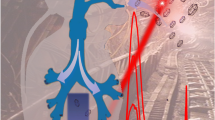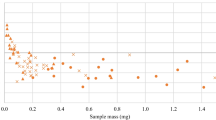Summary
The investigation and monitoring of suspended particulate matter in air require accurate and sensitive multielement analysis of large numbers of samples. In the work described, airborne particles and settled urban dusts were examined by energy dispersive X-ray fluorescence spectrometry with secondary-target excitation. The practical requirements of trace-element determinations in dusts are reasonably satisfied by two techniques. Deposition of fine particles (under 3.5μm) on Nucleopore membrane filters provides thin-film samples, for which absorption and particle-size effects are usually negligible. Calibration is achieved by sputtering of certified NBS standard glasses onto membrane filters. In the destructive “fusion and direct solidification” technique, sample inhomogeneities and particle-size effects are eliminated by fusing the sample with lithium borate in a Pt/Au alloy crucible. La2O3 or WO3, added as heavy absorbers, can reduce the interelement-effects of the thick specimens to a certain extent. A newly developed computer program, based on a modified mathematical expression for the intensity, compensates for absorption and secondary fluorescence effects. It is demonstrated that for some trace elements the background can be easily predicted as a linear function of the incomplete charge-collection of the Si(Li) detector. An intermethod comparison with atomic-absorption results is presented; the results are verified with the NBS Fly Ash standard reference material.
Zusammenfassung
Die Untersuchung und Überwachung luftgetragener, feiner Stäube erfordert eine hinreichend genaue und empfindliche Multielement-Analysen-methode, die eine schnelle Bestimmung von Serienproben ermöglicht.
Es wird über die Untersuchung luftgetragener Staubteilchen und sedimentierter Stadtstäube mittels energiedispersiver Röntgenfluoreszenzspektrometrie mit Sekundärtargetanregung berichtet. Den praktischen Anforderungen einer Spurenbestimmung in umweltrelevanten Staubmatrices wird dabei durch folgende 2 Methoden entsprochen.
Feine luftgetragene Staubteilchen unter 3,5μm werden auf Nucleopore Membranfilter abgeschieden und direkt mittels EDXRF zerstörungsfrei gemessen. In diesen quasi unendlich dünnen Schichten sind Matrixeffekte und Teilchengrößeneffekte praktisch zu vernachlässigen. Die Eichung erfolgt mittels dünner Schichten, die durch „Sputtering“ von NBS-Gläsern mittels Argon-Ionenstrom hergestellt werden.
Werden die Proben mit Li2B4O7 in einem Pt/Au-Tiegel zu homogenen glasartigen Scheibchen geschmolzen, so lassen sich alle Inhomogenitätsund Teilchengrößen-Effekte, die eine Analyse stören, vermeiden. La2O3 oder WO3, den Proben als „schwerer Absorber“ zugesetzt, reduziert die Interelementeffekte der praktisch unendlich dicken Proben. Es wird über ein neu entwickeltes Computerprogramm zur Datenreduktion berichtet, das nach der theoretischen und empirischen Methode für Absorptionsund Interelementeffekte korrigiert. Es wird gezeigt, daß für einige Spurenelemente der Untergrund eine lineare Funktion der „incomplete charge collection“ des Si-(Li-)Detektors ist und auf empirischem Wege einfach berechnet werden kann.
Abschließend wird ein Methodenvergleich mit der AAS präsentiert; die Ergebnisse werden mit dem Standardreferenzmaterial NBS Fly Ash verifiziert.
Similar content being viewed by others
References
J. M. Jaklevic, B. W. Loo, and F. S. Goulding, LBL-4834, January, 1976.
D. A. Gedcke, E. Elad, and P. B. Denee, X-Ray Spectrometry6, 21 (1977).
R. L. Myklebust, C. E. Fiori, D. N. Breiter, and K. F. J. Heinrich, Data Reduction Procedure for Monochromatic X-Ray Fluorescence Analysis with a Si (Li) Detector. Washington: National Bureau of Standards.
Author information
Authors and Affiliations
Additional information
This work was done when K. E. Lorber was at the National Bureau of Standards.
Rights and permissions
About this article
Cite this article
Lorber, K.E., Wegscheider, W., Spitzy, H. et al. Development of EDXRF techniques for the quantitative multielement analysis of urban dust samples. Mikrochim Acta 69, 209–218 (1978). https://doi.org/10.1007/BF01201726
Received:
Issue Date:
DOI: https://doi.org/10.1007/BF01201726




